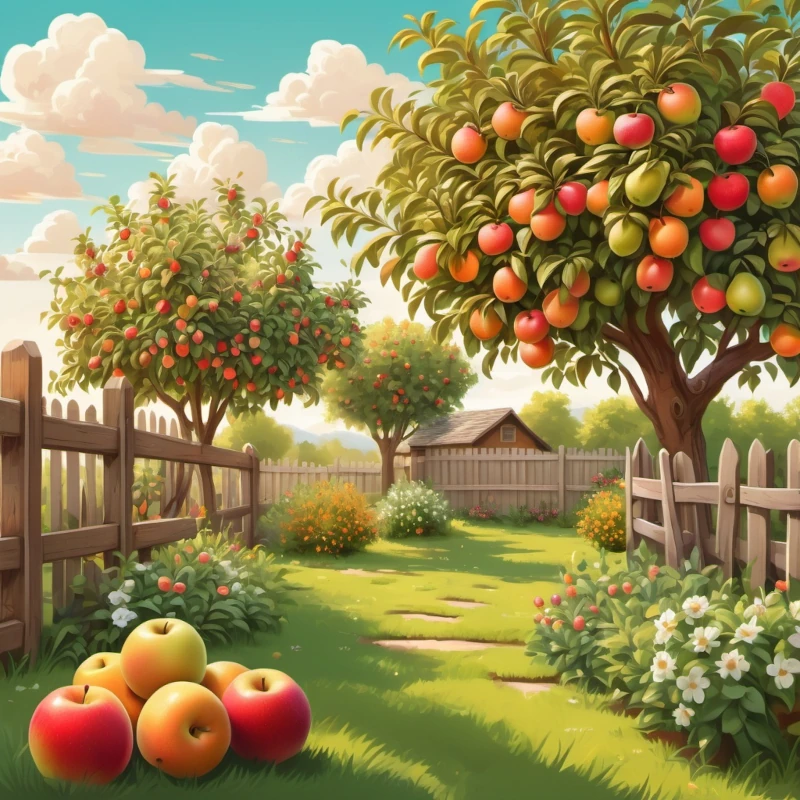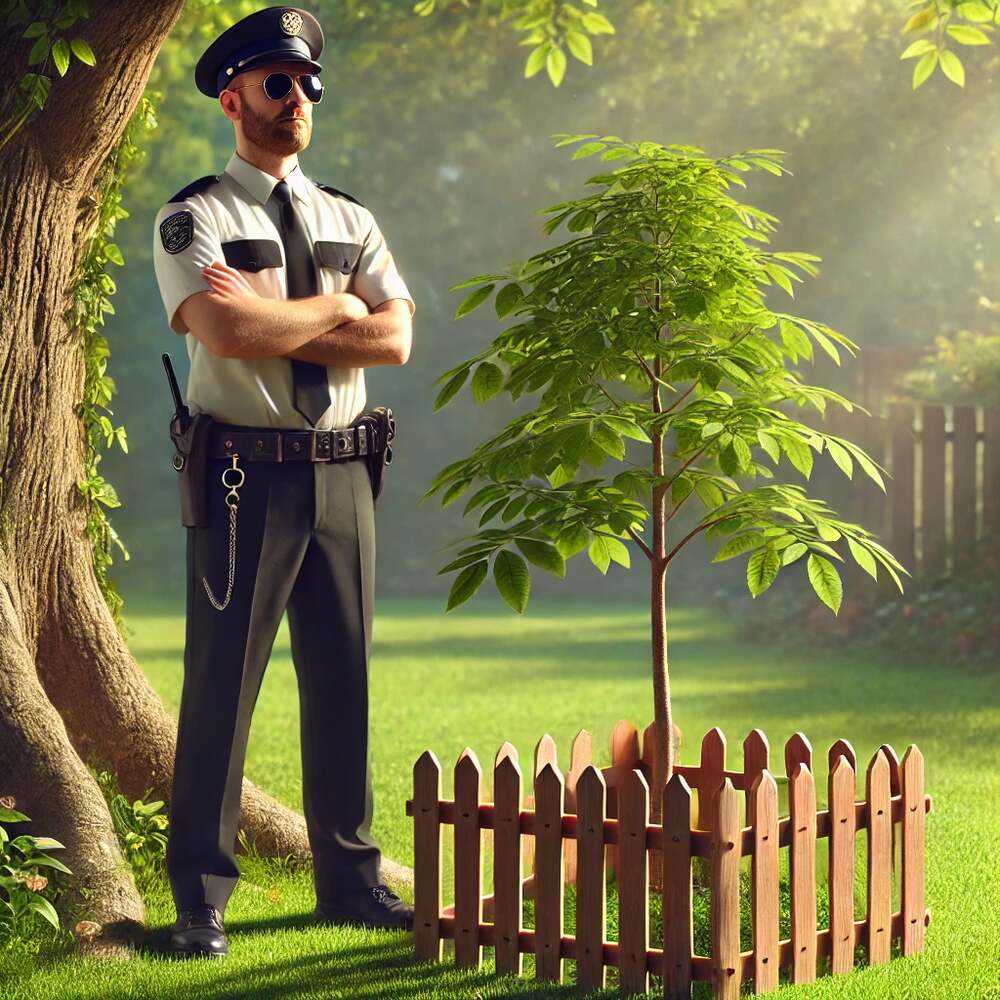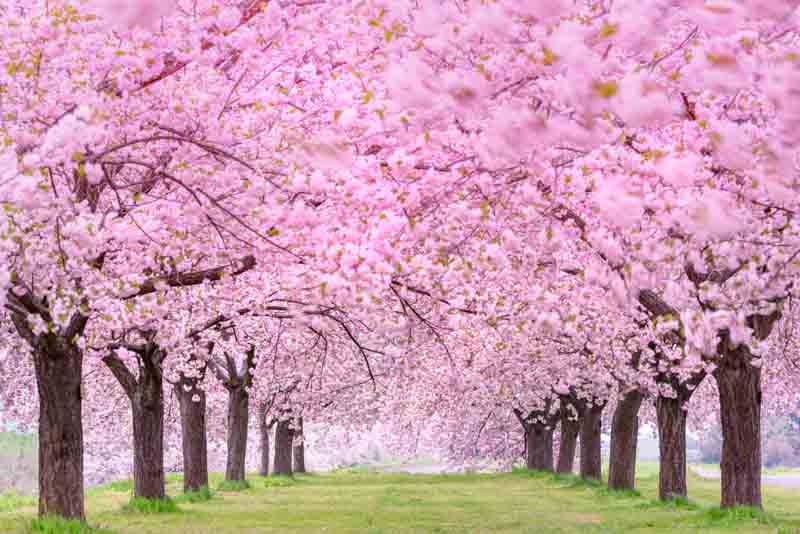Discover the essentials of selecting, planting, and caring for fruit trees with our comprehensive guide. Growing your own fruit is more than just a rewarding hobby—it’s a sustainable way to save money, reduce your environmental impact, and enjoy the unmatched taste of homegrown produce. Whether you’re planning a small backyard orchard or simply adding a single fruit tree to your landscape, making informed choices is the first step toward success. From understanding your growing conditions to mastering planting techniques, this guide will help you cultivate a thriving, productive tree with confidence.
Table of Contents
- Assessing Your Environment
- Preparing Your Soil
- Selecting the Right Tree
- Planning Your Orchard or Garden Layout
- Planting Your Fruit Tree
- Caring for Your Tree
- Planning for Harvest
- Common Mistakes to Avoid
- FAQs
- What Are Chill Hours, and Why Are They Important?
- Can I Grow Fruit Trees in a Container?
- How Do I Know When My Tree is Ready to Harvest?
- Should I Prune My Fruit Tree, and When?
- How Can I Tell if My Tree is Over-Watered or Under-Watered?
- What Is the Difference Between a Self-Pollinating Tree and One That Needs Cross-Pollination?
- Can I Grow Fruit Trees in Poor Soil?
- What Are the Best Trees for Beginners?
- Why Isn’t My Tree Producing Fruit?
- What Are Tips for Long-Term Maintenance?
Assessing Your Environment
Growing a successful fruit tree starts with understanding your local environment. Each tree has unique requirements, and matching these to your growing conditions is crucial. This section covers the key factors to consider, including your USDA growing zone, chill hours, and the potential for microclimates in your area.


Growing Zones
Growing zones provide a baseline for determining which fruit trees will thrive in your region. These zones are based on average minimum winter temperatures:
- Cold Zones (1–5): Suitable for hardy trees like apples, pears, and cherries.
- Moderate Zones (6–8): Ideal for a wider variety, including plums, peaches, and figs.
- Warm Zones (9–11): Best for citrus, avocados, and tropical fruits.
Confirm your zone and cross-reference it with your chosen tree’s hardiness to avoid planting a species that cannot withstand your climate.
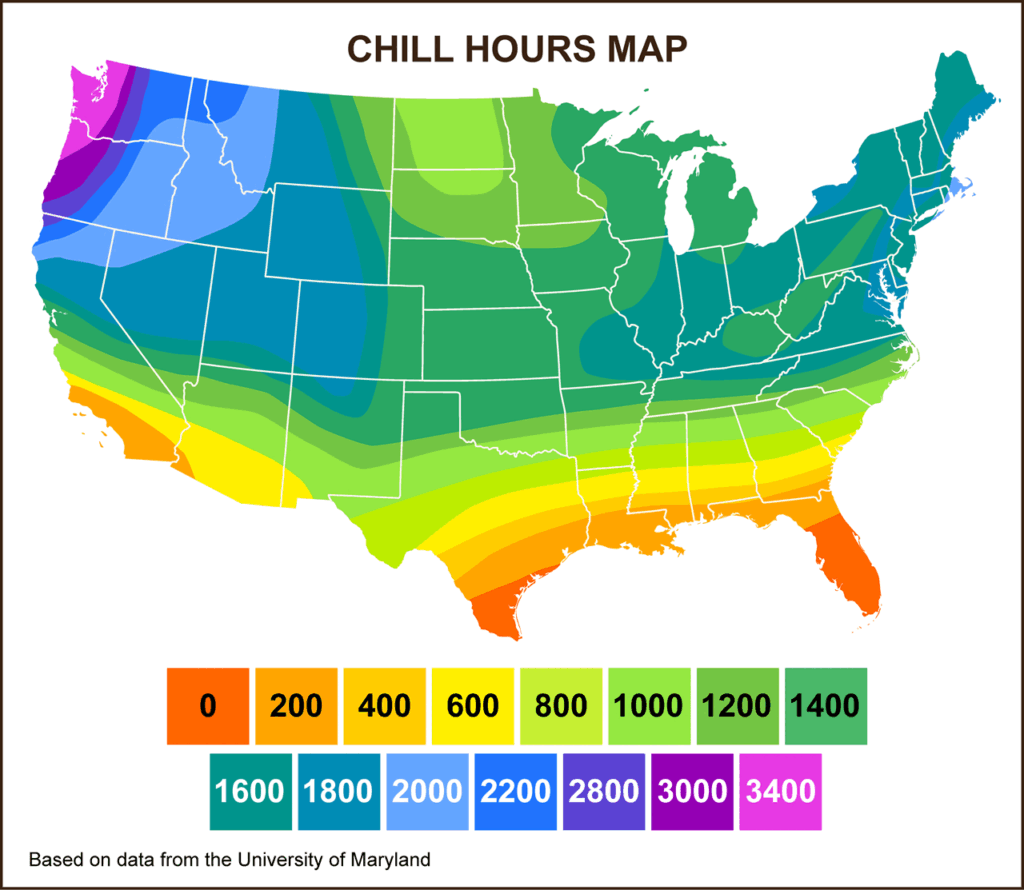
Chill Hours and Climate Considerations
Many fruit trees require a specific number of chill hours—hours below 7°C (45°F) but above freezing—to break dormancy and produce fruit.
- Low-Chill Varieties: Needed for warmer climates (zones 9–11). Examples: certain peaches and plums.
- High-Chill Varieties: Required in cooler climates (zones 3–6). Examples: apples and cherries.
Check local chill hour averages and choose varieties suited to your area. For instance, a peach tree that needs 800 chill hours won’t perform well in a region with only 300.
Identifying Microclimates
Microclimates are localized areas with distinct growing conditions, often differing from the general climate of your region. These variations can work to your advantage when selecting planting locations:
- South-Facing Slopes: Warmer and more suitable for frost-sensitive trees.
- Valleys: Cooler air can pool, increasing frost risk.
- Sheltered Areas: Walls or hedges can protect against strong winds.
Observe your property for areas with unique light exposure, temperature, or wind patterns to maximize your fruit tree’s potential.
Preparing Your Soil

Preparing the soil is one of the most critical steps in establishing healthy fruit trees. The right soil conditions ensure proper root development, nutrient uptake, and long-term tree growth.
Testing Soil Composition and pH
- Understanding Soil Testing:
- Soil tests measure the levels of essential nutrients, organic matter, and pH. These factors influence your tree’s ability to absorb nutrients.
- You can purchase a home soil testing kit or send a sample to a local agricultural extension service for detailed analysis.
- Key Parameters to Check:
- pH Levels: Most fruit trees prefer a slightly acidic to neutral soil pH of 6.0–7.0. Citrus trees may tolerate slightly more acidic conditions.
- Nutrient Levels: Test for nitrogen (N), phosphorus (P), and potassium (K), as well as micronutrients like calcium and magnesium.
- Adjusting pH and Nutrients:
- Acidic Soil: Add lime to increase pH. Incorporate gradually and retest after application.
- Alkaline Soil: Apply elemental sulfur or organic matter like pine needles or peat moss to lower pH.
- Nutrient Deficiencies: Enrich the soil with compost, well-rotted manure, or targeted fertilizers based on the soil test results.
Improving Poor Soil
- Sandy Soil:
- Characteristics: Drains too quickly, leading to nutrient leaching.
- Solution: Incorporate organic matter such as compost, well-rotted manure, or coconut coir to improve water retention and nutrient availability.
- Clay Soil:
- Characteristics: Poor drainage and aeration can suffocate roots.
- Solution: Add coarse sand, gypsum, and organic matter to break up compacted soil and improve permeability. Consider planting trees on mounds if drainage is a persistent issue.
- Compacted Soil:
- Characteristics: Roots struggle to penetrate hard soil layers.
- Solution: Aerate the soil using a broadfork or spade before planting. Mix in organic material to loosen the structure.
Enhancing Soil Fertility
- Adding Organic Matter:
- Benefits: Organic materials, such as compost, increase soil fertility, microbial activity, and structure.
- Application: Work organic matter into the soil to a depth of 12–18 inches where tree roots will grow.
- Using Cover Crops:
- Benefits: Cover crops like clover or rye replenish nutrients, prevent erosion, and improve soil texture when tilled under.
- When to Plant: Grow a cover crop the season before planting fruit trees for the best results.
- Using Mulch:
- Apply organic mulch, such as wood chips or straw, after planting to suppress weeds, retain moisture, and regulate soil temperature.
Creating Optimal Drainage
- Why Drainage Matters:
- Waterlogged roots are a leading cause of fruit tree failure. Proper drainage allows roots to access oxygen and prevents diseases like root rot.
- Drainage Solutions:
- Mounding: Create a raised planting mound (12–18 inches high) to improve drainage for heavy soils.
- Planting on Slopes: Position trees on gentle slopes to allow excess water to drain naturally.
- Installing Drainage Systems: Use drainage tiles, gravel-filled trenches, or French drains in persistently wet areas.
- Testing Drainage:
- Dig a hole about 12 inches deep, fill it with water, and let it drain. Refill it, and check how long the water takes to drain. If it takes longer than 24 hours, amend the soil or consider alternate planting techniques.
Planning for Soil Longevity
- Rotating Amendments: Avoid over-reliance on a single type of amendment to maintain balanced soil health.
- Periodic Testing: Retest soil every 2–3 years to monitor changes and adjust care as necessary.
- Encouraging Soil Microbes: Introduce mycorrhizal fungi or use compost tea to enhance soil microbial life, which benefits tree roots.
Taking the time to prepare your soil correctly provides a strong foundation for your fruit trees to thrive, ensuring healthier growth, better yields, and long-term success.
Selecting the Right Tree
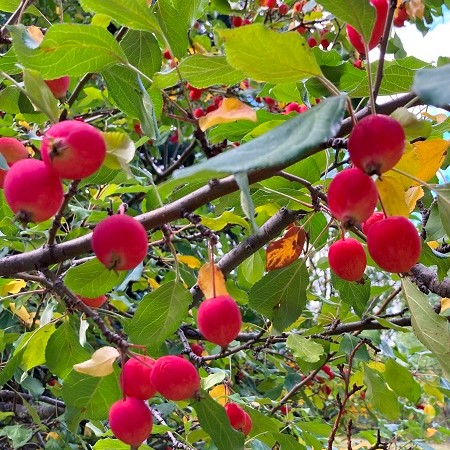
Choosing the right fruit tree for your space and growing conditions is essential for a successful harvest. Factors such as climate, space availability, and pollination requirements all play a significant role in your decision-making process.
Matching Trees to Your Climate
- Hardiness Zones:
- Each tree variety thrives in specific USDA hardiness zones. Ensure your chosen tree is suited for your region’s temperature extremes.
- Example: Apples and pears are hardy to colder zones, while citrus and figs thrive in warmer climates.
- Chill Hour Requirements:
- Most deciduous fruit trees need a certain number of chill hours (hours below 7°C or 45°F) to break dormancy and produce fruit.
- Choose trees with chill hour requirements that align with your local climate.
- Heat and Humidity Tolerance:
- For warm climates, select heat-tolerant trees like peaches or pomegranates.
- In areas with high humidity, consider disease-resistant varieties to combat fungal issues.
Space Requirements and Tree Sizes
- Tree Sizes:
- Standard Trees: Reach 15–30 feet in height and spread. Suitable for large yards or orchards.
- Semi-Dwarf Trees: Grow 12–18 feet tall and wide, ideal for medium-sized gardens.
- Dwarf Trees: Stay under 10 feet tall, perfect for small yards, patios, or container planting.
- Spacing Considerations:
- Standard trees need at least 20–30 feet between them.
- Semi-dwarf trees require 12–15 feet of spacing, while dwarf trees can be planted as close as 6–10 feet apart.
- Rootstocks:
- Rootstocks influence tree size, vigor, and adaptability to soil conditions. Research the rootstock of your chosen tree to match your space and soil needs.
Pollination and Compatible Varieties
- Self-Pollinating vs. Cross-Pollinating Trees:
- Self-Pollinating Trees: Produce fruit without another tree nearby. Examples include peaches, apricots, and some plum and cherry varieties.
- Cross-Pollinating Trees: Require pollen from a compatible variety to bear fruit. Common examples include apples, pears, and most sweet cherries.
- Planting Compatible Varieties:
- Ensure cross-pollinating trees are paired with another tree of the same species that blooms simultaneously.
- Use pollination charts or consult with local experts to choose compatible varieties.
- Attracting Pollinators:
- Enhance pollination success by planting bee-friendly flowers or introducing mason bee houses to your garden.
Other Selection Considerations
- Harvest Season:
- Choose varieties that spread out your harvest over the growing season for a continuous supply of fruit.
- Early, mid-season, and late-season varieties can provide months of fresh fruit.
- Disease and Pest Resistance:
- Select disease-resistant cultivars to reduce the need for chemical treatments. Examples include scab-resistant apple varieties and peach trees bred for resistance to leaf curl.
- Purpose of Planting:
- Choose varieties based on your intended use—fresh eating, cooking, preserving, or cider production.
- Example: Fuji apples are excellent for fresh eating, while Granny Smith is ideal for baking.
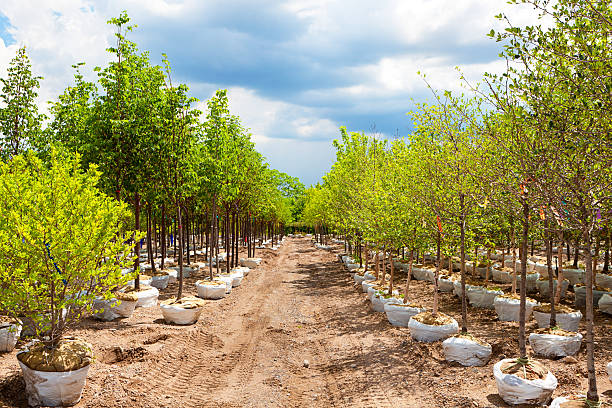
Planning Your Orchard or Garden Layout
A well-thought-out layout ensures that your fruit trees will have the space and conditions they need to thrive. Planning your orchard or garden properly can enhance growth, improve yields, and make it easier to manage your trees. This section will guide you through spacing guidelines and helpful techniques like companion planting and permaculture principles.
Spacing Guidelines for Maximum Yield
Proper spacing is critical to allow trees to grow to their full potential without competing for sunlight, nutrients, or water. Too close a planting can lead to overcrowding, reduced airflow, and increased vulnerability to pests and diseases.
- Standard Trees:
- For full-sized trees, leave at least 20–30 feet of space between each tree. This allows for proper growth, root expansion, and sufficient air circulation.
- Larger trees, such as walnuts or apples, need room to spread out their branches and roots.
- Dwarf and Semi-Dwarf Trees:
- Dwarf trees can be planted 6–10 feet apart, and semi-dwarf trees need 12–15 feet. These trees still require enough space for root growth but can tolerate tighter arrangements.
- Consider using smaller trees if you have limited space to maximize your orchard’s capacity.
- Rows and Orientation:
- Arrange trees in straight rows for easy maintenance, harvest, and air circulation. Space rows 12–20 feet apart, depending on the tree size.
- Position rows to optimize sunlight exposure. In regions with shorter growing seasons, orient the rows north to south to maximize sunlight for all trees.
- Walkways and Accessibility:
- Ensure easy access between rows for maintenance tasks such as pruning, pest control, and harvesting. Designate 3–4 feet for walkways between rows.
Companion Planting and Permaculture Techniques
Companion planting and permaculture techniques help create a diverse, sustainable environment for your trees. These methods can reduce pest pressure, enhance soil health, and promote natural biodiversity.
- Companion Planting with Fruit Trees:
- Certain plants can benefit fruit trees by attracting beneficial insects or providing natural pest control.
- Examples of good companions:
- Herbs like basil, oregano, and mint can repel pests and attract pollinators.
- Flowers such as marigolds, sunflowers, and lavender draw beneficial insects like bees and ladybugs that help with pollination and pest control.
- Garlic and onions can help repel aphids, borers, and other pests.
- Nitrogen-Fixing Plants:
- Plant legumes like clover, peas, or beans around your fruit trees. These plants naturally fix nitrogen in the soil, enriching it for tree growth.
- Comfrey is another useful plant that brings up nutrients from deeper soil layers and can be used as a mulch.
- Mulching and Ground Covers:
- Use organic mulches (e.g., straw, leaves, grass clippings) around your trees to maintain soil moisture, suppress weeds, and regulate soil temperature.
- Ground covers like vetch or clover can help protect the soil from erosion and maintain soil structure.
- Permaculture Zones:
- A permaculture layout divides your garden into zones based on the frequency of use and care. Zone 1 (closest to your home) is for high-maintenance plants like herbs, and Zone 5 (furthest from your home) is for wild areas or less frequently used plants.
- Fruit trees are often placed in Zone 2 or 3, where they receive less frequent but consistent care.
- Polyculture Planting:
- Instead of planting a monoculture of one type of tree, consider mixing different fruit tree varieties and other compatible plants. This approach can reduce the spread of pests and diseases and promote a more resilient garden.
- For example, pairing apple trees with cherries or pears allows for cross-pollination while also encouraging diverse insect populations.
Maximizing Yield and Sustainability
- Pruning and Training:
- Proper pruning techniques, like central leader or open-center training, can help ensure that trees grow upright and efficiently use the available space. Well-pruned trees also produce better yields and are easier to manage.
- Prune trees during dormancy (late winter or early spring) to avoid damaging new growth.
- Water Management:
- Design your layout with water efficiency in mind. Position trees in areas that receive natural water flow or design irrigation systems (e.g., drip irrigation) to minimize water waste.
- Consider using rainwater catchment systems to reduce your dependence on external water sources.
- Polyculture and Soil Health:
- Healthy soil leads to healthy fruit trees. Use composting and organic amendments to enrich soil quality and maintain long-term fertility.
- In a permaculture system, practicing no-till gardening or cover cropping helps build healthy soil without disturbing its structure.
By taking the time to plan your orchard or garden layout carefully, you can create a thriving, sustainable environment that supports healthy fruit production while minimizing labor and resource use. The principles of spacing, companion planting, and permaculture techniques will help you achieve a garden that is productive, diverse, and eco-friendly.
Planting Your Fruit Tree
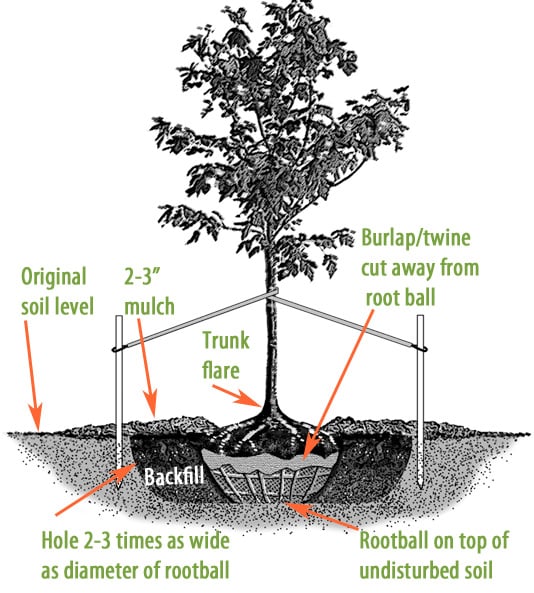
Planting your fruit tree properly is essential for its long-term health and productivity. Whether you’re planting a tree from a nursery container or transplanting a bare-root tree, the method of planting can have a significant impact on its growth. This section covers step-by-step planting instructions, the differences between container and in-ground planting, and seasonal tips to help your tree thrive.
Step-by-Step Planting Instructions
Whether you’re planting a young tree in a container or a bare-root tree, following proper planting techniques ensures your tree will establish strong roots and begin to thrive.
- Prepare the Site:
- Choose the Right Spot: Select a site with well-drained soil, good sunlight (at least 6–8 hours of direct sun per day), and protection from strong winds. Avoid areas prone to frost pockets, as these can harm young trees.
- Check the Soil: Ensure the soil is well-draining and rich in organic matter. If needed, amend the soil by adding compost or organic matter. The ideal pH for most fruit trees is slightly acidic (6.0–6.5).
- Digging the Hole:
- Container Trees: Dig a hole that is twice as wide and the same depth as the root ball of the container. This allows the roots to spread out and take hold easily.
- Bare-root Trees: Dig a wide, shallow hole to accommodate the root system. The hole should be about 2–3 times the width of the root spread and deep enough to place the roots without bending them.
- For all trees, loosen the soil at the bottom of the hole to encourage root penetration.
- Preparing the Tree:
- Container Trees: Gently remove the tree from its pot. If the roots are root-bound (i.e., tightly circling the pot), make a few vertical cuts on the root ball to encourage the roots to spread.
- Bare-root Trees: Soak the roots in water for several hours before planting to rehydrate them. Trim any broken or damaged roots with clean, sharp scissors or pruning shears.
- Planting the Tree:
- Place the tree in the center of the hole, ensuring the root collar (where the roots meet the trunk) is level with the soil surface. For bare-root trees, arrange the roots in a natural spread, and fill the hole with soil, tamping it down gently to eliminate air pockets.
- For container trees, backfill the hole with soil, ensuring the root ball is stable and the tree is standing upright. Be careful not to bury the trunk, as this can cause rotting.
- Water the tree thoroughly after planting to settle the soil around the roots.
- Mulching and Watering:
- Apply a 2–3 inch layer of mulch (e.g., wood chips, straw, or leaves) around the base of the tree, but keep it away from the trunk. Mulch helps retain moisture, suppresses weeds, and improves soil health over time.
- Water the tree deeply after planting, ensuring the soil is moist but not waterlogged. Consistent watering in the first few weeks will help the tree establish its root system.
- Staking and Support:
- If necessary, stake the tree to provide support, especially if it’s in a windy location. Use soft ties (e.g., tree tie or old cloth) to avoid damaging the trunk. Stakes should only be left in place for the first year of growth and removed once the tree is established.
Container vs. In-Ground Planting
When it comes to planting fruit trees, you may be deciding whether to plant in-ground or keep your tree in a container. Each method has its own advantages and challenges, and choosing the best option depends on your space, climate, and long-term goals for the tree.
- Container Planting:
- Advantages:
- Ideal for small spaces like patios, balconies, or areas with poor soil.
- Easier to move and manage, especially in cold climates where you can move the tree indoors during the winter.
- Allows for easier maintenance and control over water and soil conditions.
- Challenges:
- Requires regular watering and fertilization, as containers dry out more quickly than in-ground planting.
- Limited space for roots, so the tree may need to be repotted as it grows.
- May not produce as large a harvest as in-ground trees due to limited root space.
- Ensure the container has proper drainage to prevent waterlogging.
- Advantages:
- In-Ground Planting:
- Advantages:
- Trees planted in the ground have access to a larger, more stable root system, which helps them grow more vigorously and produce more fruit.
- Requires less frequent watering once established, as the soil holds moisture better than containers.
- More resilient to temperature extremes since the ground insulates the roots.
- Challenges:
- Requires more space and is permanent—relocating an in-ground tree is challenging.
- Soil conditions must be suitable, and some amendments may be necessary to improve drainage and fertility.
- Trees may take longer to establish their root systems initially.
- Advantages:
Seasonal Planting Tips
Planting at the right time can help ensure your tree establishes quickly and produces healthy fruit.
- Best Planting Times:
- Early Spring (Before Bud Break): This is the optimal time to plant bare-root trees. The cooler temperatures and dormancy period allow the tree to establish roots before the growing season starts.
- Late Fall (Before Ground Freezes): Fall is another excellent time to plant, especially in regions with mild winters. Planting in fall allows the roots to start establishing while the tree is still dormant. Be sure to plant early enough for the tree to acclimate before the first freeze.
- Container Trees: Can be planted throughout the growing season, from spring to early fall. However, avoid planting during extreme heat or drought, as newly planted trees can struggle to establish in such conditions.
- Avoid Planting During Extreme Weather:
- Heat Waves: Avoid planting during the hottest months of the year, as extreme heat can stress the tree and hinder root development.
- Frost: Planting right before the frost season can damage young trees. Ensure your tree has had enough time to establish before temperatures drop.
- Watering During Establishment:
- During the first year of planting, trees require more frequent watering. Water deeply to encourage deep root growth. In warmer months, ensure that the soil does not dry out completely.
Caring for Your Tree
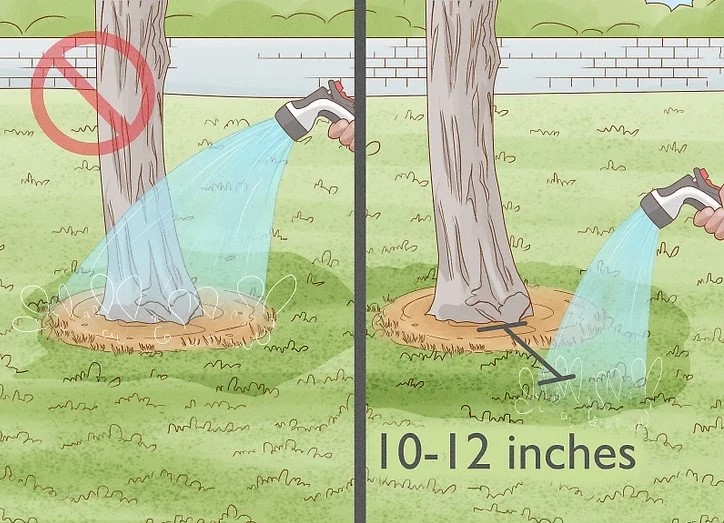
Proper care is essential to ensure that your fruit tree grows strong and produces abundant, healthy fruit. This section covers key aspects of tree care, including watering and fertilization, pruning for health and productivity, and managing pests and diseases to keep your tree thriving.
Watering and Fertilization
Watering:
Proper watering is critical during the first few years of a fruit tree’s life, as this is when the tree is establishing its root system. Once the tree is established, it will be more drought-tolerant, but consistent watering remains important, especially during dry periods.
- Young Trees:
- For newly planted trees, water thoroughly to ensure the soil is moist to a depth of 6–12 inches. Water deeply rather than frequently to encourage deep root growth.
- Frequency: Water the tree deeply once a week if there’s no significant rainfall, and more often during hot weather. A good rule of thumb is to give the tree 1 inch of water per week.
- Watering Method: Using a slow-release watering system or a soaker hose is ideal, as it allows water to soak deeply into the soil without runoff.
- Established Trees:
- Once the tree is established, you can reduce the frequency of watering. During the growing season, trees typically need deep watering every 10–14 days, depending on the weather.
- For trees that are bearing fruit, consistent moisture is crucial to prevent fruit drop or poor fruit development. Be sure to water consistently during the fruiting period.
- Avoid Overwatering:
- While watering is important, excessive water can lead to root rot. Make sure the soil drains well, and avoid letting the roots sit in waterlogged soil. Ensure the area around the tree has adequate drainage, particularly in areas that receive heavy rainfall.
Fertilization:
Fertilizing your tree correctly will provide it with the necessary nutrients for healthy growth and optimal fruit production. However, over-fertilizing can cause excessive foliage growth at the expense of fruit.
- When to Fertilize:
- Spring: Apply a balanced, slow-release fertilizer in the early spring before new growth begins. This will help the tree develop strong shoots and leaves.
- Mid-Summer: If your tree is producing fruit, a second application of a low-nitrogen fertilizer can support fruit development.
- Fall: Avoid fertilizing in the fall, as this can stimulate late-season growth that may not have enough time to harden off before the winter cold sets in.
- Types of Fertilizer:
- Balanced Fertilizer: A general 10-10-10 (N-P-K) fertilizer works well for most fruit trees, providing an even mix of nitrogen, phosphorus, and potassium.
- Organic Fertilizers: Compost, well-rotted manure, or fish emulsion can be great organic alternatives to synthetic fertilizers. These can improve soil structure and increase microbial activity, which supports overall tree health.
- Signs of Nutrient Deficiency:
- If the leaves of your tree are yellowing, fruit is smaller than expected, or growth appears stunted, the tree may be lacking essential nutrients. Perform a soil test to identify nutrient deficiencies and adjust your fertilization schedule accordingly.
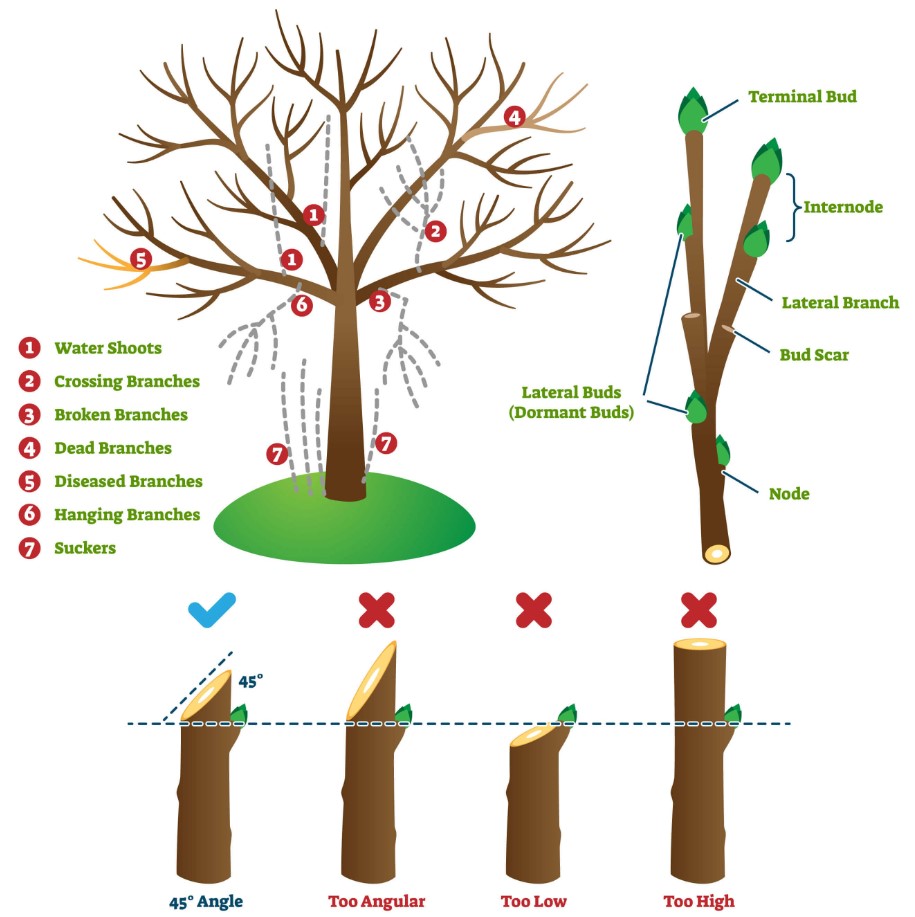
Pruning for Health and Productivity
Pruning is a critical aspect of fruit tree care. It not only helps maintain the shape of the tree but also encourages healthy growth, improves air circulation, and enhances fruit production. Proper pruning reduces the risk of disease and pest infestation and helps manage tree size.
- When to Prune:
- Late Winter to Early Spring: The best time to prune fruit trees is during their dormant period, typically in late winter or early spring before new growth begins. This minimizes the risk of disease and encourages strong growth in the spring.
- Summer Pruning: Light pruning during the growing season can help manage the tree’s shape and remove any diseased or dead branches.
- Basic Pruning Cuts:
- Remove Dead, Diseased, or Damaged Wood: Cut back any wood that is dead, damaged, or diseased to prevent it from spreading to healthy areas.
- Thin Out Dense Branches: To improve air circulation, remove any inward-growing branches and thin out dense areas to allow sunlight to reach all parts of the tree.
- Cut Back Suckers and Water Sprouts: Suckers (shoots that grow from the base of the tree) and water sprouts (fast-growing vertical shoots) can drain the tree’s energy and should be removed.
- Shape the Tree: Maintain a central leader (main trunk) for most fruit trees, removing competing leaders or branches that cross or rub against each other.
- Fruit Production:
- For fruit trees, proper pruning helps balance vegetative growth (leaves and branches) with reproductive growth (fruiting). Avoid heavy pruning during the growing season, as it can reduce the tree’s ability to produce fruit.
- Annual Pruning: Each year, remove any dead or weak wood, while focusing on shaping the tree and encouraging strong, productive branches.
Pest and Disease Management
A healthy fruit tree is better equipped to resist pests and diseases, but even the most carefully tended trees can face challenges. Being proactive with pest and disease management can help protect your fruit tree from damage and ensure a good harvest.
- Identifying Pests and Diseases:
- Common Pests: Aphids, scale insects, spider mites, caterpillars, and fruit flies are some of the common pests that can harm fruit trees. Regularly inspect the tree for signs of pest infestation, such as discolored or curled leaves, webs, or visible insects.
- Common Diseases: Fungal infections like powdery mildew, rust, and blight, as well as bacterial diseases like fire blight, can affect fruit trees. Look for blackened or discolored leaves, lesions on fruit, and oozing sap as signs of infection.
- Preventative Measures:
- Mulching: Apply mulch around the base of the tree to help control weeds, maintain moisture, and reduce the risk of soil-borne diseases.
- Pruning: Remove any diseased or infected parts of the tree to prevent the spread of pests and diseases. Clean your pruning tools between cuts to avoid transferring pathogens.
- Cleanliness: Rake up fallen leaves and fruit, as these can harbor pests and fungal spores. Discard them far from the tree to reduce the chances of reinfection.
- Natural Pest Control:
- Beneficial Insects: Encourage natural predators like ladybugs, lacewings, and predatory beetles to help control pests.
- Neem Oil and Insecticidal Soap: For pest control, consider using organic treatments like neem oil or insecticidal soap, which are safe for beneficial insects and help control pest populations. Always follow the manufacturer’s instructions to avoid harming your tree or the environment.
- Chemical Control:
- When Necessary: If pest problems become severe, chemical pesticides may be necessary. Use them as a last resort and choose those that are appropriate for fruit trees. Always follow the instructions for safe application.
- Integrated Pest Management (IPM): Use IPM practices to combine cultural, biological, and chemical controls to manage pest and disease issues in the most environmentally friendly way possible.
- Monitoring and Response:
- Regular Inspections: Inspect your tree regularly for signs of pests or disease, especially during the growing season. Catching problems early can help prevent larger infestations.
- Treatment Timing: Apply treatments when pests are most vulnerable, typically in the early stages of infestation. Some treatments, like insecticidal soaps or oils, are more effective when applied in the morning or evening when pollinators are not active.
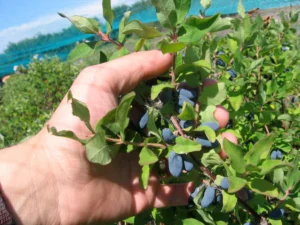
Planning for Harvest
Harvesting your fruit at the right time ensures that your tree’s bounty reaches its peak flavor, texture, and nutritional value. This section provides guidance on estimating fruit yield, recognizing the signs of ripeness, and tips for storing and preserving your fruit for enjoyment long after the harvest.
Estimating Fruit Yield
Before your fruit trees start bearing fruit, it’s helpful to estimate how much fruit you can expect each year. While this can vary depending on factors such as tree age, health, and environmental conditions, understanding what to expect can help you plan for harvest time and determine how to store or preserve your crop.
- Tree Age and Size:
- Fruit trees typically begin to bear fruit 3–5 years after planting, depending on the species and whether the tree is grown from seed or grafted. The first few years may yield a smaller crop, but as the tree matures, the yield will increase.
- Young trees may produce 10–20% of their mature yield in the first few years, with mature trees reaching full production at 10–15 years, depending on the variety.
- Fruit Variety and Tree Health:
- Different varieties of fruit trees can have varying yields. For instance, dwarf trees generally produce smaller quantities than standard-sized trees, but they may begin producing fruit sooner. Healthy trees with proper care will yield more fruit. If your tree has been well-maintained in terms of water, nutrients, and pest control, you can expect a robust harvest.
- Pollination: Some fruit trees are self-pollinating, while others require cross-pollination from another tree of the same species. If your tree is not self-pollinating, make sure you have a compatible pollinator nearby to ensure optimal fruit production.
- Environmental Factors:
- Factors such as soil quality, weather, and water availability will influence how much fruit a tree produces. Dry spells, excessive rain, or temperature fluctuations during the growing season can impact the overall yield.
- In some cases, fruit trees may have an “off year,” where the yield is less than usual. This can occur naturally in trees that bear fruit every other year or are stressed by environmental conditions.
- Estimating Yield Per Tree:
- Small Trees: Dwarf and semi-dwarf trees typically produce 20–40 pounds of fruit per tree when fully mature.
- Standard Trees: Standard-sized trees can produce between 50–100 pounds or more of fruit per tree, depending on the variety.
- You can get a better estimate of yield as your tree matures and becomes more consistent in its production.
Tips for Storing and Preserving Fruit
After harvest, proper storage and preservation will help you enjoy the fruits of your labor throughout the year. Whether you plan to eat them fresh or preserve them for later use, these tips can help you make the most of your harvest.
- Harvesting at the Right Time:
- Ripeness Indicators: The best time to harvest fruit is when it is fully ripe. Signs of ripeness vary by fruit type but generally include a change in color, firmness, and sometimes the ease with which the fruit detaches from the tree.
- Apples: Apples should be firm and have a balanced flavor. They can be gently twisted off the tree when ripe.
- Peaches and Plums: These fruits should yield slightly to pressure and have a deep color. They can be harvested when they have a pleasant aroma and feel slightly soft.
- Citrus Fruits: Citrus should be fully colored and slightly firm when ripe.
- Berries: Harvest berries when they have reached their full color and are plump.
- Avoid Overripe Fruit: Picking fruit at its peak will result in the best flavor and storage life. Overripe fruit is more prone to bruising and rapid deterioration.
- Ripeness Indicators: The best time to harvest fruit is when it is fully ripe. Signs of ripeness vary by fruit type but generally include a change in color, firmness, and sometimes the ease with which the fruit detaches from the tree.
- Storing Fresh Fruit:
- Cold Storage: Most fruits (like apples, pears, and citrus) can be stored in a cool, dark place. Refrigerating fruits like berries or grapes helps extend their shelf life, though it’s best to eat them within a few days.
- Room Temperature: Some fruits, like peaches, nectarines, and tomatoes, ripen better at room temperature. Once ripe, they can be stored in the fridge to extend freshness.
- Preserving Fruit for Long-Term Storage:Freezing:
Freezing is an excellent way to preserve fruit for extended periods. Most fruits can be frozen by washing and cutting them into appropriate sizes.- Blanching: For fruits like peaches and plums, blanching (briefly boiling and then cooling them in ice water) helps preserve texture and flavor.
- Freezing Techniques: Lay fruit in a single layer on a baking sheet, freeze until solid, and then transfer to freezer bags or containers to prevent clumping.
Canning allows you to store fruit for months or even years. Be sure to use proper canning methods to prevent spoilage.- Fruit Preserves: Jams, jellies, and fruit preserves are great ways to enjoy the flavor of fruit long after harvest. These are typically made with added sugar and pectin to help with preservation.
- Canning: Use sterilized jars and lids, and follow specific instructions for water-bath or pressure canning, depending on the fruit type.
Dehydrating fruit removes moisture, preventing the growth of spoilage-causing bacteria.- Methods of Drying: You can use a food dehydrator, an oven, or even sun-drying methods to preserve fruit. Apples, apricots, and berries all dry well.
- Storage: Once dried, store the fruit in airtight containers in a cool, dry place. Dried fruit can last for several months or even years, depending on storage conditions.
- Fermentation:
For certain fruits, such as grapes or apples, fermentation can be an effective preservation method. This process involves turning the sugar in the fruit into alcohol or vinegar, which can be used to make wine, cider, or vinegar. Fermented fruits have a long shelf life and offer unique flavors. - Using Preserved Fruit:
Preserved fruit can be used in baking, cooking, or simply as a snack. Dried fruit is excellent for trail mixes, cereal toppings, or rehydrated in water for use in pies and preserves. Canned fruit is often added to dishes, while frozen fruit can be used for smoothies, baking, or as toppings.
Common Mistakes to Avoid
While fruit tree care can be incredibly rewarding, it’s easy to make mistakes that can hinder the growth and productivity of your trees. This section highlights some common missteps that even experienced gardeners can make, and provides tips on how to avoid them to ensure your trees thrive.
Over- or Under-Watering
Proper watering is essential for healthy fruit trees, but it’s easy to overdo it or not water enough. Both over-watering and under-watering can cause stress to your trees, leading to poor growth, fruit drop, or disease.
- Over-Watering:
- Over-watering can lead to root rot, which suffocates the roots and prevents them from absorbing essential nutrients. Symptoms of over-watering include yellowing leaves, wilting, or root decay.
- To avoid this, ensure your tree’s soil drains well and only water when the top few inches of soil are dry.
- Water deeply to encourage deep root growth, but allow the soil to dry out between waterings.
- Under-Watering:
- On the flip side, under-watering causes stress and can stunt growth or result in smaller, less flavorful fruit. Trees that are underwatered will show signs of dry, brittle leaves, wilting, and a lack of vigor.
- Ensure that your tree receives a consistent amount of water, especially during hot weather. A good rule of thumb is to water deeply once or twice a week, depending on rainfall and temperature.
- Solution:
- Invest in a soil moisture meter or simply check the soil with your fingers to ensure proper watering. Make sure the root zone is moist but not soggy.
Neglecting Pollination Needs
Pollination is a critical factor for fruit production, yet many gardeners overlook the pollination requirements of their trees. While some fruit trees are self-pollinating, others require a different tree variety nearby for proper fertilization.
- Self-Pollinating Trees:
- Many trees, like certain apple, pear, and cherry varieties, can produce fruit on their own without needing a second tree. However, even these trees often produce a better yield when cross-pollinated by another variety of the same species.
- Always check the pollination requirements for your tree to ensure it can produce fruit on its own, or if another tree is necessary for pollination.
- Cross-Pollination Requirements:
- Trees that require cross-pollination, like sweet cherries or certain apple varieties, need another tree of a compatible variety nearby. If you only plant one tree, it may not produce fruit.
- Ensure that the second tree is within 50–100 feet of the first tree to facilitate effective pollination.
- Solution:
- Plant multiple varieties of fruit trees when possible to improve the chances of successful pollination, especially for non-self-pollinating varieties. Check bloom times to ensure that the trees flower at the same time.
Planting in Unsuitable Conditions
Fruit trees are sensitive to their growing environment, and planting them in unsuitable conditions can stunt growth or lead to disease problems. It’s important to consider factors such as soil quality, sunlight, and space before planting your tree.
- Poor Soil Quality:
- Planting a tree in soil that is too compacted, too sandy, or too acidic can hinder its growth. Nutrient deficiencies, poor drainage, or soil diseases can develop if the soil is not suitable.
- Symptoms of poor soil include slow growth, yellowing leaves, or wilting.
- Lack of Sunlight:
- Fruit trees require full sunlight to thrive and produce fruit. Planting trees in shaded or overly sheltered areas will result in poor growth and minimal fruit yield.
- Ideally, fruit trees should receive at least 6–8 hours of direct sunlight each day.
- Improper Space:
- Planting trees too close together or in confined spaces can prevent them from reaching their full potential. Crowded trees compete for nutrients, water, and sunlight, leading to weak growth and lower fruit production.
- Additionally, trees that are planted too close to buildings or other structures may have restricted root growth, leading to stressed trees.
- Solution:
- Before planting, assess your tree’s specific needs. Check that the soil is well-draining, fertile, and has the correct pH for your tree variety.
- Select a location that receives full sun and ensures enough space for your tree to grow to its full size.
- Regularly amend soil with organic matter or compost to improve soil health and drainage. Test your soil’s pH and make adjustments if necessary.
Other Common Mistakes
- Planting Too Deep:
- Planting trees too deeply can suffocate the roots and lead to poor growth. The root crown (where the roots meet the trunk) should be level with or slightly above the soil surface.
- Neglecting Pruning:
- Failing to prune your fruit trees can result in overcrowded branches, poor air circulation, and limited fruit production. Pruning helps shape the tree, remove dead or diseased wood, and encourage strong new growth.
- Ignoring Mulching:
- Mulching around the base of fruit trees helps retain moisture, suppress weeds, and regulate soil temperature. Avoid piling mulch directly against the trunk, as this can lead to rot.
- Over-Fertilizing:
- Over-fertilizing your fruit tree with excessive nitrogen can encourage lots of leaf growth at the expense of fruit production. Use a balanced fertilizer and follow recommended application rates.
FAQs
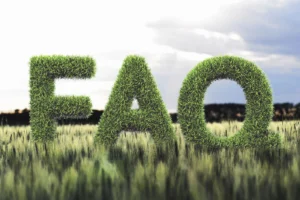
What Are Chill Hours, and Why Are They Important?
Chill hours refer to the number of hours a fruit tree needs to experience cold temperatures (typically between 32°F and 45°F or 0°C to 7°C) during winter. This period helps break the tree’s dormancy, enabling it to bloom and bear fruit in the spring. Without enough chill hours, trees may produce little or no fruit. To ensure success, select tree varieties with chill hour requirements that match your climate zone.
Can I Grow Fruit Trees in a Container?
Yes, many fruit trees, especially dwarf or semi-dwarf varieties, thrive in containers. Container gardening is perfect for patios, balconies, or smaller spaces. Be sure to use a large container with proper drainage, water regularly, and provide nutrients as needed. Keep in mind that container-grown trees may require more frequent care than those planted in the ground.
How Do I Know When My Tree is Ready to Harvest?
Harvest timing depends on the fruit type and variety. Look for visual cues like color changes, fruit size, and texture. Gently taste a few fruits for ripeness, and ensure they come off the tree easily with a gentle twist. For crops like apples, peaches, or pears, proper harvesting ensures optimal flavor and storage life.
Should I Prune My Fruit Tree, and When?
Yes, pruning is crucial for health, shape, and fruit production. The best time to prune is during the dormant season—late winter to early spring—before new growth begins. Avoid excessive pruning during the growing season to prevent stress. Remove dead or diseased wood, and maintain a structure that allows sunlight and airflow to reach the tree’s interior.
How Can I Tell if My Tree is Over-Watered or Under-Watered?
Over-watering can cause yellow leaves, root rot, or a soggy root system. Under-watering leads to dry, brittle leaves, wilting, or stunted growth. To strike the right balance, water deeply and let the soil dry between waterings. Check the soil moisture with your finger or use a moisture meter to avoid both extremes.
What Is the Difference Between a Self-Pollinating Tree and One That Needs Cross-Pollination?
Self-pollinating trees can produce fruit on their own, but they often yield more with cross-pollination. Trees requiring cross-pollination need at least one other compatible variety nearby to produce fruit. Research the pollination needs of your chosen variety to ensure compatibility and maximize harvests.
Can I Grow Fruit Trees in Poor Soil?
Fruit trees prefer well-draining, nutrient-rich soil. Poor soil, such as sandy or clay-heavy types, can be improved with compost or organic matter. Conduct a soil test to identify deficiencies, and amend as needed. Avoid planting in waterlogged or overly compacted soil to prevent root issues like rot.
What Are the Best Trees for Beginners?
For new gardeners, beginner-friendly fruit trees like apple, plum, or fig trees are great options. These trees adapt to a range of conditions and require minimal maintenance. Dwarf varieties are especially manageable in smaller spaces or containers.
Why Isn’t My Tree Producing Fruit?
Fruit production issues could stem from insufficient chill hours, lack of pollination, or an incompatible climate. Assess the tree’s specific needs, including sunlight, water, and nutrients. Providing the right care and environment is key to solving fruiting problems.
What Are Tips for Long-Term Maintenance?
Regular pruning, fertilizing, and monitoring for pests and diseases ensure a long, productive life for your tree. Mature trees may require less frequent feeding but still need consistent care. Older trees might benefit from organic compost to revitalize growth and production.

